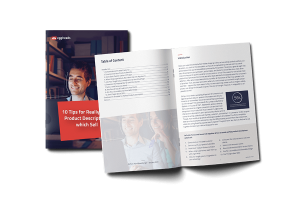Product Communications
The Force of Convincing Product Descriptions

Content
Product Descriptions – Must-Have or Disposable?
“Product descriptions are boring and unimportant. Let’s be honest, who even reads texts on your product pages? There are so many other, more important things on your website when it comes to the optimization of your customer conversation rate. Product descriptions don’t actually influence your sales numbers.” Right? Wrong!
Did you know that smart product descriptions with the right information and fitting content can increase your customer conversion rate by 57 percent? Or that one out of six orders are returned, caused either by false or bad product descriptions in 30 percent of these cases? (Source: https://de.ax-semantics.com/)
In short: Product descriptions are important, in particular in e-commerce. You want to know what makes for a good product description, how to create them, and how to easily avoid potential errors? In this case, you should definitely read further.
What does a convincing product description include?
Before taking a deep-dive into the topic of product descriptions, we should make sure that we’re on the same page as far as the concept itself goes:
A product description is much more than a simple stringing-together of technical data and hard facts. It’s the marketing text which explains the product and describes the use cases for which the product is purchased. The purpose of a product description is to provide customers with relevant information about features and benefits of the product, enhancing their trust in your product, online shop, and brand.
The classic product description has a clear and distinct structure:
- Headlines: Show what you’ve got – in the heading, you name the product.
- Teaser: In the teaser, you describe in a brief but precise manner why potential customers should purchase your product. Here is the right place for the most important information about your product, including all SEO-relevant keywords. This is because even the most beautiful product description and the best product are useless if they can’t be found via search engines.
- Description Proper: Become creative. The product description should effectively seduce your potential customers. Prove the benefits of your product but invest great care into addressing your target group in strategic manner to convince your customer to make a purchasing decision.
- Hard Facts: Important product properties do also have their dedicated spot in the product description Create a table or formulate in a concise bullet-point list all technical data and essential facts about your product, e.g. size, material, or color. The customer wants all info at a glance.
- Call To Action: Don’t forget to include CTAs. This motivates the consumer to become active and encourages a direct sale.
Now that we have a clear-cut overview of the structure, nothing can go wrong. Right? There’s still a long way to go. To be more precise, many companies have the tendency to repeat the following errors when designing product descriptions.
The No-Goes of Product Descriptions: These are the Mistakes You Should Avoid
1. Describing the Obvious
Owners of online shops and e-commerce stores as well as marketers are all prone to the same frequent errors when writing texts (even professional copywriters do it from time to time): Simply describing what the customer can see at first glance when looking at the product images. What’s wrong with that? It’s wrong since good product descriptions are to complement your product page. You’re selling products to real people. Product descriptions aren’t just some secondary source of information solely serving the purpose to feed search engines (granted, of course, that SEO should never get the short end of the stick either).
2. Ignoring the Target Group
Always keep the following in mind when writing texts: your product description should be thoroughly target group oriented. Consistency is key. Only with content that addresses the target group in a strategic manner, can you make sure that customers receive the information they need and get that extra bit of motivation that’s still missing to encourage the purchasing decision.
Adopt the customer’s first-person perspective and see your product through their eyes to familiarize yourself with how they think, identifying the missing link between customer and product. To do so, you can create buyer personas or analyze your feedback data compiled in Google Analytics and elsewhere. Use the following questions as a guide:
- Who is your customer?
- What problems are solved by your product?
- What use does your product have for customers?
- What separates your product from the competition?
3. Empty Phrases
“A first-class offer at the absolute best price” – how often have we heard sentences like these? Exactly, way too often. The deflationary use of buzzwords such as “best price” or “top offer” have long lost their appeal. Avoid empty phrases and filler words in your descriptions. Since they complicate the reading flow and don’t contribute to the customer’s understanding of the product. Instead, place your trust in unique content which inspires customers and provides convincing arguments.
4. Facts, Facts, and Facts
Companies often times make the mistake to simply list attributes of products when writing product descriptions. How can you convince customers to buy your product if you don’t tell them how the product can make their life easier? This can leave a fatal impact on your sales numbers – if customers don’t feel like you’re meeting them on their own ground, they won’t buy your product. Regardless of how good it is. What works wonders is to imagine how it feels like if you were buy the product in a shop yourself and how you would go about selling it. Try to preserve some of that conversational feel in your written text, make the text come to life and write it as if it were spoken. This includes more than simply arranging mere numbers and facts about the given article. Rather than enumerating various information, it’s primarily about winning and strengthening the trust of your customers in your products.
5. Low-Quality Texts and Wrong Information
Last but not least: Always check twice whether or not your product information is fully up-to-date and consistent. Imagine for a second that you want to buy a product, but the information and descriptions provided are incomplete, irrelevant, or maybe even wrong and self-contradictory. If this were the case, would you actually commit to buying this product? No, since wrong product information strongly implies unprofessionalism and dubiousness. Good thing that this pitfall is easily avoided – granted that you do invest a bit more work into your product data. Product data is the foundation of each and every product description. If your data is well-maintained, such a faux pas will never occur. Central data processing with a PIM system is the optimal solution for all use cases.
Why the Effort?
Put your hand on your heart and ask yourself: What’s the state of the product descriptions provided to potential customers in your shop? Do you simply reproduce the information which can already be gathered by glancing at the product image or does your unique content provide additional value to the overall presentation? Your customer’s standards become higher and higher, so that simple descriptions do no longer suffice. Shops which provide high-quality product texts inspire interest and passion which, in turn, translates into a higher costumer conversation rate for your online shop.
A well-formulated product description guides your customer through the conversion bottleneck. With some little creativity, your product pages will become much more convincing and lead to more conversions. Especially among occasional buyers. So, how exactly do you write such ideal product descriptions? Are there tools and templates which can help me in doing so? You will find all the answers you need in our free whitepaper.
From Our Blog
You may also be interested in the following articles








